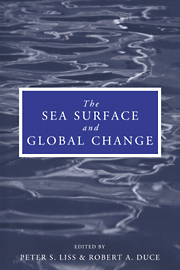Book contents
- Frontmatter
- Contents
- List of contributors
- Preface
- 1 Report Group 1 – Physical processes in the microlayer and the air–sea exchange of trace gases
- 2 Report Group 2 – Biological effects of chemical and radiative change in the sea surface
- 3 Report Group 3 – Photochemistry in the sea-surface microlayer
- 4 Transport processes in the sea-surface microlayer
- 5 The role of organic films in air–sea gas exchange
- 6 Bubbles and their role in gas exchange
- 7 The physical chemistry of air–sea gas exchange
- 8 The sea-surface microlayer and its effect on global air–sea gas transfer
- 9 Chemistry of the sea-surface microlayer
- 10 Biophysics of the surface film of aquatic ecosystems
- 11 Biological effects of chemicals in the sea-surface microlayer
- 12 Neuston of seas and oceans
- 13 Photochemistry in the sea-surface microlayer
- 14 Hydrocarbon breakdown in the sea-surface microlayer
- 15 Applications of laser technology and laser spectroscopy in studies of the ocean microlayer
- 16 Remote sensing of the sea-surface microlayer
- Index
13 - Photochemistry in the sea-surface microlayer
Published online by Cambridge University Press: 24 September 2009
- Frontmatter
- Contents
- List of contributors
- Preface
- 1 Report Group 1 – Physical processes in the microlayer and the air–sea exchange of trace gases
- 2 Report Group 2 – Biological effects of chemical and radiative change in the sea surface
- 3 Report Group 3 – Photochemistry in the sea-surface microlayer
- 4 Transport processes in the sea-surface microlayer
- 5 The role of organic films in air–sea gas exchange
- 6 Bubbles and their role in gas exchange
- 7 The physical chemistry of air–sea gas exchange
- 8 The sea-surface microlayer and its effect on global air–sea gas transfer
- 9 Chemistry of the sea-surface microlayer
- 10 Biophysics of the surface film of aquatic ecosystems
- 11 Biological effects of chemicals in the sea-surface microlayer
- 12 Neuston of seas and oceans
- 13 Photochemistry in the sea-surface microlayer
- 14 Hydrocarbon breakdown in the sea-surface microlayer
- 15 Applications of laser technology and laser spectroscopy in studies of the ocean microlayer
- 16 Remote sensing of the sea-surface microlayer
- Index
Summary
Abstract
Due to the photochemical production and atmospheric deposition of highly reactive species at the sea surface, the microlayer could well act as a highly efficient microreactor, effectively sequestering and transforming select materials brought to the interface from the atmosphere and oceans by physical processes. However, very little is known about the optical and photochemical properties of this regime. Based on the measured enrichments of light absorbing material in the microlayer and employing photochemical quantum yields obtained for bulk waters, photochemical production rates and fluxes are estimated for the microlayer. The microlayer fluxes are generally small with respect to atmospheric deposition and the water column fluxes. This result argues that the microlayer is unlikely to act as a ‘reaction barrier’ to the exchange of trace gases across the interface. However, the higher photochemical production rates at the surface should lead to the more rapid oxidative turnover of materials at the interface and potentially to reactions and processes not observed in bulk waters.
Introduction
The sea-surface microlayer acts as a dynamic interface mediating the exchange of matter, heat, momentum, and electromagnetic radiation between the earth's oceans and atmosphere. The accumulation of surface-active material within this thin oceanic layer – defined operationally as the top 0.03 to 500 μm depending on the sampling method employed (Liss, 1986; Hunter and Liss, 1981; Carlson, 1982b) –has been shown by workers over the last several decades to alter the physical and chemical properties of the interface.
- Type
- Chapter
- Information
- The Sea Surface and Global Change , pp. 383 - 424Publisher: Cambridge University PressPrint publication year: 1997
- 25
- Cited by

